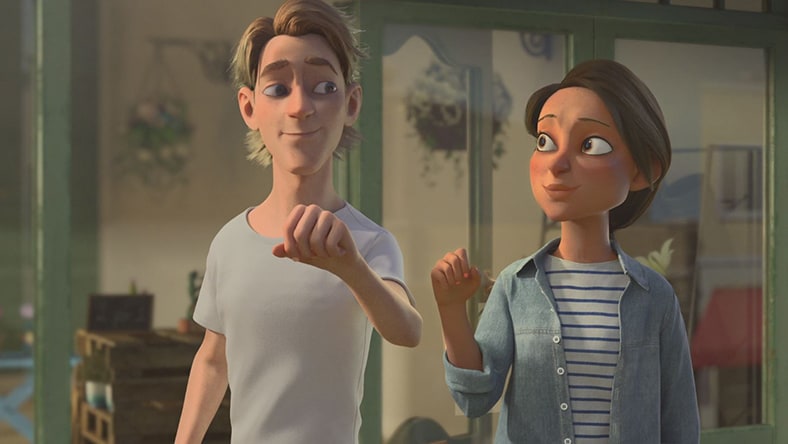& Construction

Integrated BIM tools, including Revit, AutoCAD, and Civil 3D
& Manufacturing

Professional CAD/CAM tools built on Inventor and AutoCAD
Stop-motion animation is the art form of creating a motion picture from sequences of still images. Stop-motion animators can capture a scene using puppets, figurines, or cutouts, slightly manipulating the objects between each still image. They then sequence the images together to create a movie.
The Humpty Dumpty Circus (1898) is credited as the first ever stop-motion animation. The technique has proliferated ever since, being used in a great many productions, notably King Kong (1933), Gumby (1955), the original Star Wars trilogy of the 1970s and ’80s, and The Nightmare Before Christmas (1993). Today, animators use advanced stop-motion animation software to help streamline the time-honored traditions of the genre.
Stop-motion animators reshape modeling clay sculptures frame by frame to create a motion picture.
Artists build each scene of the stop-motion animation using flat cutouts of material like paper or fabric.
Animators utilize everyday objects such as toys or dolls. Lego toys are particularly popular.
Artists apply stop-motion techniques to human actors who pose for long series of photos.
Puppet characters, slowly manipulated for each photo, supply the action.
The stop-motion animator backlights objects to create shadows, which are then captured as still images.
Stop-motion animation is a rewarding but painstaking art, requiring the sequencing of more than 100,000 still images for a feature-length production. Sophisticated stop-motion animation software makes the task significantly easier.
Animators can save time and resources by creating digital models of characters, sets, and facial expressions in stop-motion programs before building or 3D printing the physical parts.
Powerful cloud-based stop-motion animation software centralizes mountains of data, making it accessible from anywhere and coordinating smooth workflows between artists, directors, producers, and production managers.
Stop-motion software with machine learning–based generative scheduling can spread many thousands of tasks across a large team in minutes, and then adjust for changing variables on the fly.
One of the most significant and talked about stop-motion animation features in recent years was Guillermo del Toro’s reimagining of the classic tale Pinocchio. Animation and production studio SHADOWMACHINE were instrumental in making the stop-motion animation a success; they used Autodesk’s Flow Production Tracking software to coordinate the massive effort between the many stop-motion animators and other team members. Watch this Autodesk University talk featuring Art Department Production Manager Whitney Schmerber.
Since the early days of stop-motion animation, it has found uses in many different applications.
Many beloved films have used stop-motion animation in part or for the whole movie, including family fare like Coraline and Frankenweenie, and feature productions such as Mad God by VFX wizard Phil Tippet and Charlie Kauffman’s comedy-drama Anomalisa.
Short films made with stop-motion animation have etched themselves in cinema history, including Wallace & Gromit: The Wrong Trousers.
Stop-motion animation can be used for marketing purposes, helping capture audiences’ attention and make a brand stand out.
As an art form, stop-motion animation offers a highly creative and expressive medium with which to share artistic ideas with the world.
Scale your studio’s rendering and simulation capabilities, while equipping artists with powerful modeling and animation tools
Because stop-motion animation consists of a sequence of still images, sound effects and music must be applied separately. This addition of sound is as important as capturing the images—it will enhance the animation for the audience, allowing them to suspend disbelief and become immersed in the narrative. Sound and music are also integral in creating mood, atmosphere, and tone. You can use stop-motion animation software such as Flow Production Tracking to coordinate the visual and sound elements of your production effectively.
Award-winning stop-motion studio LAIKA uses Generative Scheduling in Flow Production Tracking (formerly ShotGrid), as well as Maya and Inventor to design digital models and facial expressions before physical production.
Image courtesy of LAIKA
PASSION PICTURES
Production company Passion Pictures combined CGI with stop-motion, including 3D printed model heads, to produce a hybrid animation ad.
Image courtesy of Passion Pictures
SHADOWMACHINE
To handle the stop-motion animation of Guillermo del Toro’s Pinocchio after the pandemic required sudden remote work, Portland’s SHADOWMACHINE turned to Autodesk Flow Production Tracking as a centralized source of truth for scheduling.
Image courtesy of Netflix
Chris Ohlgren of HouseSpecial explains some of the real-life differences between working on highly collaborative computer animation and the straightforward but laborious grind of stop-motion animation.
Award-winning feature-length stop-motion animation studio combines classic stop-motion techniques with CGI from Autodesk Maya and thousands of digitally designed 3D-printed puppet parts to achieve its feature Missing Link.
A duo of experienced animators uses Autodesk Fusion to create a time-saving, highly versatile stop-motion animation puppet.
Stop-motion animation requires a few basic elements, including:
Depending on the type of stop-motion animation, you’ll need a variety of materials to create your characters and the worlds they inhabit.
Image courtesy of LAIKA
The quality of your animation depends on the quality of the camera you use to capture each image. A DSLR camera is best, but modern smartphones can yield impressive results for amateurs. You’ll also need a tripod to ensure that the camera remains still between shots.
Image courtesy of Shangyu Wang
An armature is essentially a skeleton for the figures and props that you will be animating. It may be made of wire or similar materials and allows you to move and pose your characters in the positions you need.
Image courtesy of RADiCAL
Don’t underestimate the importance and impact of lighting in stop-motion animation. LED lights, reflectors, and more can be used to provide focus and set the atmosphere and tone of your piece.
Image courtesy of Tabatha Hugues
Stop-motion animation is created by artists arranging puppets, clay figurines, paper cutouts, or other physical objects into a scene and taking a photo. The stop-motion animation artists then manipulate the objects slightly, take another photo, and repeat that process many times, often 30 photos per second of film time.
This large quantity of still images is sequenced in order within specialized stop-motion animation software with capabilities designed for stop-motion animation to create a motion picture. The resulting animation is then edited like any other video, including adding music, voiceover, and sound and visual effects.
There are six major types of stop-motion animation:
The main difference between 3D animation and stop-motion animation is in the medium of what’s being animated.
For 3D animation, artists create 3D models and environments within software and can manipulate them in innumerable ways, potentially making photorealistic images. With stop-motion animation, artists manipulate physical objects and photograph them frame by frame to create a film with sequenced still images.
While the cost of 3D animation is coming down, stop-motion animation can generally be done with a lower budget than 3D animation. Both animation styles can be very time-consuming.
The difference between 2D animation and stop-motion animation is drawings vs. physical objects. Both styles create frame-by-frame animation, which lines up a series of images in sequence to create the illusion of movement.
For 2D animation, artists draw images by hand or in software, and for stop-motion animation, they photograph scenes of manipulated physical objects. Stop-motion software can aid the process, helping organize it and increase efficiency.
The method of cutout animation—where flat cutouts of paper, fabric, or other materials are arranged to create images frame by frame—blurs the line between 2D drawn animation and 2D stop-motion animation.















